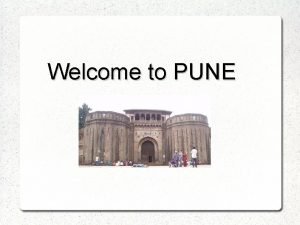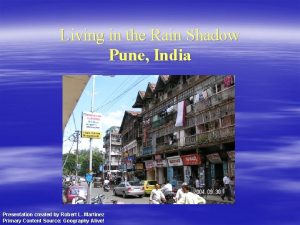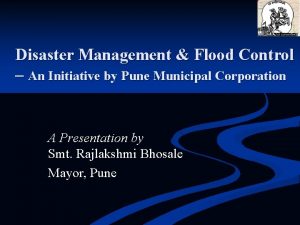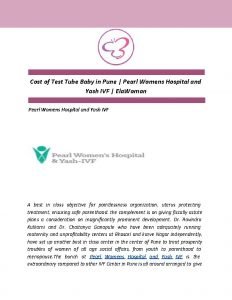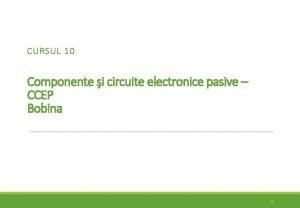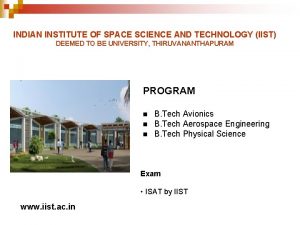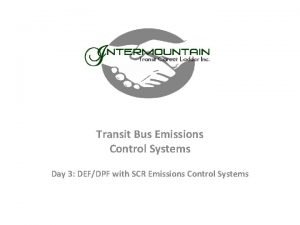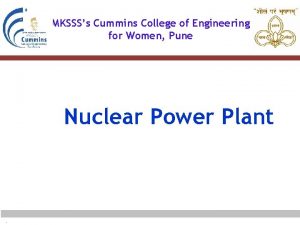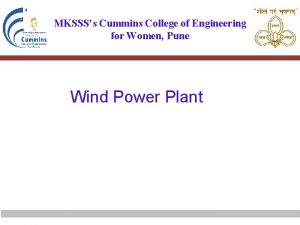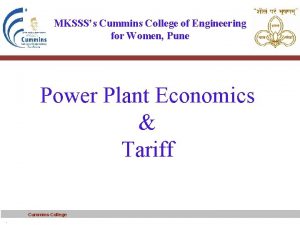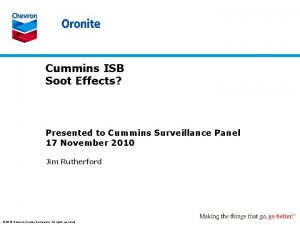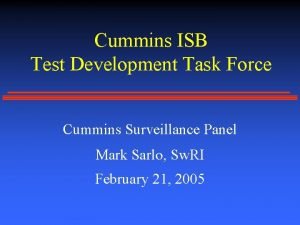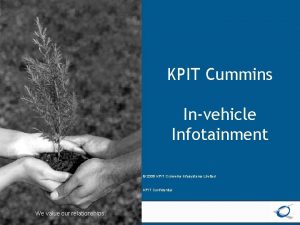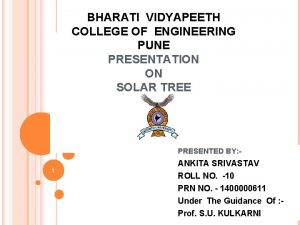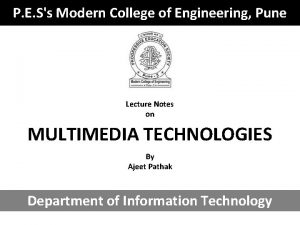MKSSSs Cummins College of Engineering for Women Pune





















- Slides: 21

MKSSS’s Cummins College of Engineering for Women, Pune Management of Radioactive Waste P. S. Chaware .

Definition of radioactive waste • Radioactive waste is any material that is either radioactive itself or is contaminated by radioactivity, for which no further use is envisaged

Categories of Radioactive Waste • The term ‘radioactive waste’ covers a wide variety of material, ranging from wastes that can be put safely into a dustbin to items that need remote handling, heavy shielding and cooling to be managed safely. To be clear, radioactive waste is considered in different categories. – Low Level – Intermediate Level – High Level

Categories of Radioactive Waste • Low level waste is not dangerous but sometimes requires shielding during handling. • Intermediate level waste typically is chemical sludge and other products from reactors. • High level waste consists of fissionable elements from reactor cores and transuranic wastes. • Transuranic waste is any waste with transuranic alpha emitting radionuclides that have half-lives longer than 20 years.

Low Level Waste (LLW) • Low level waste is any waste that could be from a high activity area. • 90% volume of waste • It does not necessarily carry any radioactivity. • Split into four catagories: A, B, C, and GTCC.

Intermediate Level Waste (ILW) • Intermediate level waste requires shielding when being handled. • 7% volume of waste • Dependent on the amount of activity it can be buried in shallow repositories.

High Level Waste (HLW) • High level waste has a large amount of radioactive activity and is thermally hot. • 95% of radioactivity • Current levels of HLW are increasing about 12, 000 metric tons per year. • Most HLW consists of Pu-238, 239, 240, 241, 242, Np-237, U-236

Transuranic Waste (TRUW) • Transuranic waste consists of all waste that has radionuclides above uranium. • TRUWs typically have longer half-lives than other forms of waste. • Typically a byproduct of weapons manufacturing.

Creation of Nuclear Waste • Nuclear waste is generated at all points of the fuel cycle. • Front end waste consists primarily of low level alpha emission waste. • Service period waste typically includes LLW and ILW such as contaminated reactor housings and waste from daily operation. • Back end waste normally is the most radioactive and includes spent fuel rods and reactor cores.

Front End Waste • Front end waste consists mostly of LLW and ILW. • The primary front end waste is depleted uranium and radium. – DU has several uses due to its high density (19, 050 kg/m 3). – Mix with uranium to form reactor fuel

Service Period Waste • Consists of mostly ILW. • Mostly waste produced at the plant during normal operation. • Spent fuel rods are the most dangerous waste produced during the service period.

Back End Waste • Nuclear waste developed during the back end of the fuel cycle is the most dangerous and includes most of the HLW produced. • Most back end waste emits both gamma and beta particles. • Also uranium-234, neptunium-237, plutonium-238 and americium-241 are found in back end waste. Spent nuclear fuel in a cooling pond in North Korea.

• Once created, radioactive waste will undergo some of the following stages depending on the type of waste and the strategy for its management • Pretreatment – is the initial step that occurs just after waste generation. It may involve collection, segregation, chemical adjustment and decontamination and may also include a period of interim storage. The aim of this step is to segregate waste into streams that will be managed in similar ways, and to isolate non-radioactive wastes or those materials that can be recycled.

• Treatment – involves changing the characteristics of the waste by volume reduction, radionuclide removal or change of composition. Typical treatment operations include: – Compaction of dry solid waste or incineration of solid or organic liquid wastes (volume reduction); – Ciltration or ion exchange of liquid waste (radionuclide removal); and – Precipitation or flocculation of chemical species (change of composition).

• Conditioning – Involves transforming radioactive waste into a form that is suitable for handling, transportation, storage and disposal.

• Storage – Waste might be stored for many years before it undergoes further processing and disposal. Some storage facilities are located within a nuclear power plant or a licensed disposal facility, others are separate facilities.

Methods of Disposal • N- Waste can be disposed of following ways – – Deep Geological Disposal Reprocessing Transmutation Space Disposal

Deep Geological Disposal • The process of geological disposal centers on burrowing nuclear waste into the ground to the point where it is out of human reach. • Concerns; – Material leak – Contamination of water table – Terrorism

Reprocessing • Involves taking waste and separating the useful components from those that aren’t as useful. • Involves taking the fissionable material out from the irradiated nuclear fuel. • Concerns; – Nuclear Proliferation – How much easier re-processing would allow fissionable material to spread.

Transmutation • Transmutation – Involves converting a chemical element into another less harmful one – Common conversions include going from Chlorine to Argon or from Potassium to Argon

Space Disposal • Putting nuclear waste on a space shuttle and launching the shuttle into space. • Concerns; – Amount of nuclear waste that could be shipped on a single shuttle would be extremely small compared to the total amount of waste that would need to be dealt with. – Possibility of the shuttle exploding en route to space could only make the matter worse
 Sm joshi college pune
Sm joshi college pune Cauvery college for women
Cauvery college for women Psgr krishnammal college for women
Psgr krishnammal college for women Welcome to pune in marathi
Welcome to pune in marathi Siguria ne pune projekt
Siguria ne pune projekt Pune, india, has tried to increase its rainfall by
Pune, india, has tried to increase its rainfall by E dictate
E dictate Pune flood control
Pune flood control Ddhs pune
Ddhs pune Sadhana vidyalaya hadapsar pune 28
Sadhana vidyalaya hadapsar pune 28 Top 10 german language classes in pune
Top 10 german language classes in pune Test tube baby cost in pune
Test tube baby cost in pune Urethra
Urethra Sci-edge abstracts
Sci-edge abstracts Inductanta magnetica
Inductanta magnetica Lokmanya tilak hospital chinchwad
Lokmanya tilak hospital chinchwad Pune me projekt
Pune me projekt Om chambers bhosari
Om chambers bhosari Afosop pune
Afosop pune Indian institute of space science and technology
Indian institute of space science and technology Pune branch of wirc
Pune branch of wirc Cummins def dosing unit location
Cummins def dosing unit location



